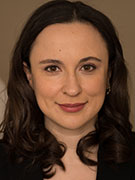RSNA Presents Alexander Margulis Award to MRI Study of Plaque
Released: December 01, 2014
- RSNA Media Relations
1-630-590-7762
media@rsna.org
CHICAGO, Ill.—The Radiological Society of North America (RSNA) presented its third Alexander R. Margulis Award for Scientific Excellence to Anna E. H. Zavodni, M.D., and colleagues, for the article, "Carotid Artery Plaque Morphology and Composition in Relation to Incident Cardiovascular Events: The Multi-Ethnic Study of Atherosclerosis (MESA)," published in Radiology in May 2014.
Named for Alexander R. Margulis, M.D., a distinguished investigator and inspiring visionary in the science of radiology, this new annual award recognizes the best original scientific article published in RSNA's peer-reviewed journal Radiology.
"It is an immense privilege to receive this award and an honor to accept it on behalf of my co-authors," said Dr. Zavodni, a cardiothoracic radiologist at Sunnybrook Health Sciences Centre and assistant professor in the Department of Medical Imaging at the University of Toronto in Toronto, Canada. "I am grateful to the RSNA for this group's leadership and advocacy, as well as its engagement of junior faculty members through educational programs and seed funding. As a young investigator, I am so fortunate to work with such amazing mentors and to belong to such a strong and supportive professional society."
The study investigated the predictive value of a number of magnetic resonance imaging (MRI) features in determining the risk of subsequent cardiovascular events in an asymptomatic population.
A total of 946 participants in the Multi-Ethnic Study of Atherosclerosis (MESA) were evaluated with MRI. Patients were followed for an average of 5.5 years to determine the subsequent occurrence of major cardiovascular disease, including fatal and non-fatal myocardial infarction and cerebrovascular disease.
"We studied asymptomatic individuals with a low risk of cardiovascular events at baseline and used noninvasive imaging to predict the risk of an event downstream," said study co-author David A. Bluemke, M.D, Ph.D., from the National Institutes of Health Clinical Center in Bethesda, Md.
The paper was the first population-based, prospective study to determine if vulnerable plaque features shown on MR images add to the risk of a cardiovascular event beyond the traditional risk factors and adds to the growing body of information on biomarkers that may be used to determine the risk of major cardiovascular disease in asymptomatic individuals.
"While prior studies have recognized the importance of so-called vulnerable plaque in heralding cerebrovascular disease, much of that work was based on autopsy data or on patients with clinically significant carotid stenosis," said Herbert Y. Kressel, M.D., editor of Radiology. "This large, prospective, multicenter study has clearly shown that these findings can be recognized in asymptomatic individuals and can be predictive of longer term outcomes as well."
Cardiovascular events occurred in 59 of the patients in the study. Abnormal thickening of the carotid artery wall and the presence of a lipid core and calcium in the internal carotid artery on MRI were significant predictors of subsequent events. A lipid core was present in almost half of the patients who had an event, compared with only 17.8 percent of those who did not have an event.
"The results of our study bolster the use of MRI as a surrogate marker of efficacy in therapeutic studies and point to a role in determining which patients might need more aggressive treatments," Dr. Bluemke said. "As risk factor prediction gets better, we'll be able to screen more intelligently and use more intensive treatments in those individuals who face a higher risk of cardiovascular events."
"Carotid Artery Plaque Morphology and Composition in Relation to Incident Cardiovascular Events: The Multi-Ethnic Study of Atherosclerosis (MESA)." Collaborating with Drs. Zavodni and Bluemke were Bruce A. Wasserman, M.D., Robyn L. McClelland, Ph.D., Antoinette S. Gomes, M.D., Aaron R. Folsom, M.D., M.P.H., Joseph F. Polak, M.D., M.P.H., and João A. C. Lima, M.D.
Note: Copies of RSNA 2014 news releases and electronic images will be available online at RSNA.org/press14 beginning Monday, Dec. 1.
The Radiological Society of North America (RSNA) is an association of more than 54,000 radiologists, radiation oncologists, medical physicists and related scientists, promoting excellence in patient care and health care delivery through education, research and technologic innovation. The Society is based in Oak Brook, Ill. (RSNA.org)
Radiology is edited by Herbert Y. Kressel, M.D., Harvard Medical School, Boston, Mass., and owned and published by the Radiological Society of North America, Inc. (Radiology.RSNA.org)
